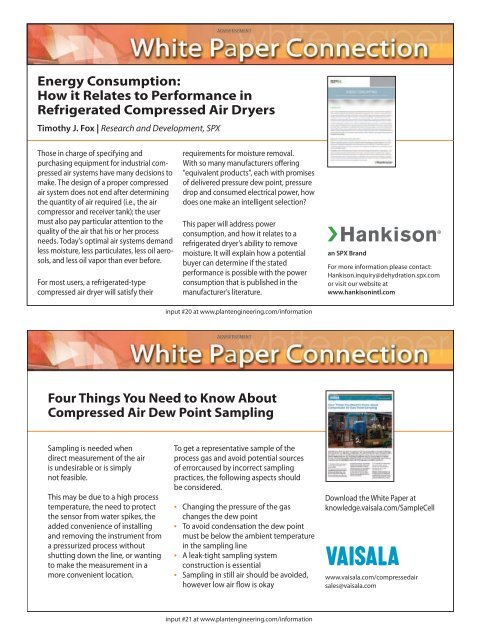2012 - PageSuite
2012 - PageSuite
2012 - PageSuite
Create successful ePaper yourself
Turn your PDF publications into a flip-book with our unique Google optimized e-Paper software.
Energy Consumption:<br />
How it Relates to Performance in<br />
Refrigerated Compressed Air Dryers<br />
Timothy J. Fox | Research and Development, SPX<br />
Those in charge of specifying and<br />
purchasing equipment for industrial compressed<br />
air systems have many decisions to<br />
make. The design of a proper compressed<br />
air system does not end after determining<br />
the quantity of air required (i.e., the air<br />
compressor and receiver tank); the user<br />
must also pay particular attention to the<br />
quality of the air that his or her process<br />
needs. Today’s optimal air systems demand<br />
less moisture, less particulates, less oil aerosols,<br />
and less oil vapor than ever before.<br />
For most users, a refrigerated-type<br />
compressed air dryer will satisfy their<br />
requirements for moisture removal.<br />
With so many manufacturers offering<br />
“equivalent products”, each with promises<br />
of delivered pressure dew point, pressure<br />
drop and consumed electrical power, how<br />
does one make an intelligent selection<br />
This paper will address power<br />
consumption, and how it relates to a<br />
refrigerated dryer’s ability to remove<br />
moisture. It will explain how a potential<br />
buyer can determine if the stated<br />
performance is possible with the power<br />
consumption that is published in the<br />
manufacturer’s literature.<br />
an SPX Brand<br />
For more information please contact:<br />
Hankison.inquiry@dehydration.spx.com<br />
or visit our website at<br />
www.hankisonintl.com<br />
ple<strong>2012</strong>11_SPX_whitePprHLF.indd 1<br />
input #20 at www.plantengineering.com/information<br />
10/29/<strong>2012</strong> 3:22:28 PM<br />
Four Things You Need to Know About<br />
Compressed Air Dew Point Sampling<br />
Sampling is needed when<br />
direct measurement of the air<br />
is undesirable or is simply<br />
not feasible.<br />
This may be due to a high process<br />
temperature, the need to protect<br />
the sensor from water spikes, the<br />
added convenience of installing<br />
and removing the instrument from<br />
a pressurized process without<br />
shutting down the line, or wanting<br />
to make the measurement in a<br />
more convenient location.<br />
To get a representative sample of the<br />
process gas and avoid potential sources<br />
of errorcaused by incorrect sampling<br />
practices, the following aspects should<br />
be considered.<br />
• Changing the pressure of the gas<br />
changes the dew point<br />
• To avoid condensation the dew point<br />
must be below the ambient temperature<br />
in the sampling line<br />
• A leak-tight sampling system<br />
construction is essential<br />
• Sampling in still air should be avoided,<br />
however low air flow is okay<br />
Download the White Paper at<br />
knowledge.vaisala.com/SampleCell<br />
www.vaisala.com/compressedair<br />
sales@vaisala.com<br />
ple<strong>2012</strong>11_whtPprHLF_vaisala.indd 1<br />
input #21 at www.plantengineering.com/information<br />
10/12/<strong>2012</strong> 10:17:06 AM

















